Hot New Additive Manufacturing Materials
Customer requirements up the ante for new materials to address biocompatibility, strength, transparency, static shock and more.
Latest News
November 1, 2011
By Susan Smith
What prototypes are made of comprises a very important part of manufacturing. The demand for new materials is unrelenting, and keeps additive manufacturing (AM) companies in constant competition to meet the need. In the past year alone, several new materials have been released, addressing such requirements as transparency, biocompatibility, static-dissipative capabilities and advanced composite materials. New research is also being done with 3D printing and tissue engineering.
Combining Temperature Resistance and Toughness
Bruce Bradshaw, director of marketing at Objet Geometries, says the company has debuted four different materials in the past year:
Objet’s claim to fame is that it has developed Connex technology, which allows you to combine two materials. Although that’s not in itself a new development, it is the basis for one of Objet’s new materials: Acrylonitrile Butadiene Styrene (ABS)-like Digital Material (RGD5160-DM).
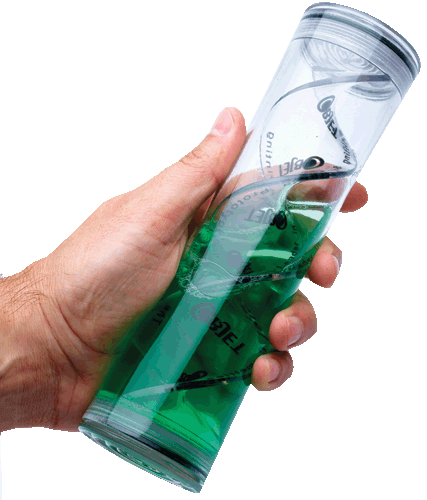
Objet’s new VeroClear can be used for anything that requires transparency.
Photo courtesy of Objet.
It helps allay a concern in manufacturing engineering plastics: the tradeoff between temperature resistance and toughness.
“You either get very high temperature resistance and the product is very brittle, or you get toughness and little or no resistance to high temperature,” says Bradshaw. “Because we can take two materials and combine them together, our ABS-like material gives us the best of both worlds. By blending two materials together, we get the material properties of a high temperature material, in which ABS-like can go up to ]203 °F] after post-processing in an oven—and we get very high toughness.”
ABS-like is used for form and function and break testing. One example is from an automotive company in Germany that leather coats its steering wheels: The process requires a high temperature to leather coat, so high-temperature molding applications are needed. Another application example would be Kohler running hot water through its faucet designs.
Bradshaw noted there are 4,000 ABS materials in the manufacturing world. Objet offers 65 different materials with its Connex technology: 14 base materials and 51 digital materials. Newly introduced materials include:
- MED610: The biocompatible material is designed for applications requiring prolonged skin contact of more than 30 days and short-term mucosal membrane contact of up to 24 hours. Examples might be Gillette testing toothbrush designs, or any company needing to check the customized fit of devices such as surgical orthopedic guides or dental delivery trays. MED610 is made in a clear material. It has five medical approvals of the standard ISO 10993-1: Cytotoxicity, Genotoxicity, Delayed Type Hypersensitivity, Irritation and USP Plastic Class VI.
- VeroWhitePlus: This material is more durable than its predecessor, VeroWhite. Plus is used in the prototyping world.
- VeroClear: This material is used for anything that requires transparency, such as lenses, plexiglass or lamps—and also in medical manufacturing for things like bottles.
Objet also offers three different groupings of printers: desktop printers, Eden family and Connex family. VeroWhitePlus works on all the printers; VeroClear and MED610 work on Eden and Connex; and ABS-like works on Connex only.
Investment Casting Materials
3D Systems’ new products—Accura CastPro, Accura PEAK and VisiJet Clear—hit the market with their varying range of capabilities: from use in investment casting patterns to designing prototypes for windtunnel models. These materials are used to build models and prototypes for functional testing, proof of concept, dental, architecture and much more.
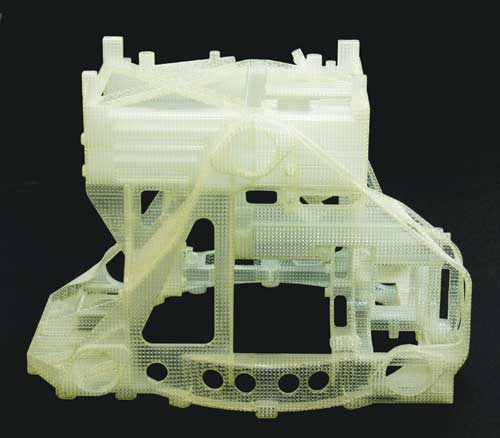
3D Systems’ Accura CastPro is designed for the production of investment
casting patterns for the QuickCast process. Photo courtesy of 3D Systems.
For use with stereolithography systems (SLA), Accura CastPro is designed for the production of investment casting patterns for the QuickCast process. The material is dimensionally stable even in humid and moist environments, making it a good candidate for highly accurate master patterns. Its low viscosity ensures drainage of very thin walls, and minimizes the amount of residual material in a pattern that needs burnout. It also has low coefficient of thermal expansion, which ensures successful burnout of casting patterns, and a high productivity rate.
Accura PEAK is designed to withstand aggressive environments with rigid and stable parts. It is stiff and resistant to moisture, and can withstand temperatures over 300 °F. It is a good choice for parts that must be accurate and stable over time, such as jigs, fixtures, master patterns/models, windtunnel models and higher-temperature applications.
VisiJet Clear was added to the VisiJet materials line for the ProJet 6000 Professional 3D printers using SLA part technology. VisiJet Clear complements the line by adding UV curable acrylic plastic with a polycarbonate look and feel—ideal for applications that require transparency. Models will allow visualization of internal structures or the study of fluid flow, and can be used for prototyping optical components such as lenses and lamps. The output for VisiJet Clear is strong and durable, according to the company.
Stephen D. Hanna, director of global sales and marketing, rapid manufacturing materials, says VisiJet Clear meets the standards of USP Class VI: “This opens the door to a variety of medically related applications, and greatly expands the utility of the PJ6000 to these customers, allowing for the potential for design and development of medical instruments, dental models, medical drill guides, surgical study models, etc.”
High Feature Detail and Soft Parts
Aslo new in the lineup of AM materials is the Iflex 500 from EnvisionTEC, for use on the Perfactory and ULTRA systems. EnvisionTEC is known for its photopolymers for manufacturing flexible soft industrial parts, and in that vein, the Iflex 500 produces soft, rubber-like parts with great tear resistance and UV stability that last for a long period of time. When properly light post-cured, the part can be used for underwater applications.
EnvisionTEC LS600 is an ABS-like photopolymer with high feature detail used on EnvisionTEC’s 3D printers. LS600 is a material that produces parts with high impact resistance similar to that of thermoplastics. It can be used in prototypes for connector and electronic covers, automotive housings and dashboard assemblies, as well as consumer sporting goods.
Static Dissipative Material
Another contribution to the list of new materials this year is ABS-ESD7 from Stratasys. Fred Fischer, director of business development, notes that this electrostatic discharge (ESD) material is used by Fortus AM systems.
ABS-ESD7 is for applications where a static charge can damage products, impair performance or cause an explosion. It prevents a buildup of static electricity. In addition, the ESD material eliminates the attraction and buildup of particulate, such as dust or powders, which are often attracted by static electricity and can degrade product performance. ABS-ESD7 is also valuable for designing products that avoid attracting atomized liquid, such as medicine inhalers, which must deliver the entire drug dose and not leave mist clinging to the inhaler’s internal surfaces.
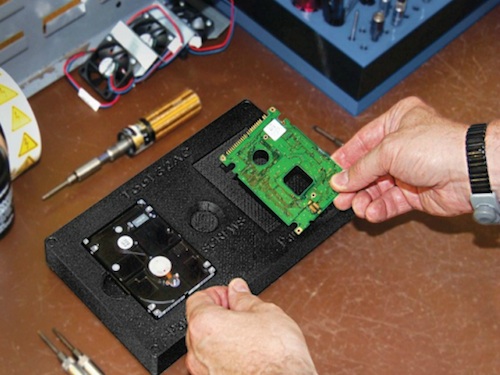
Products that are sensitive to static shock, such as printed circuit boards or
microprocessors, can benefit from the static dissipative properties of
Stratasys’ ABS-ESD7. Photo courtesy of Stratasys.
In general, all materials, whether plastics or metal, have a conductivity range. By definition, most plastics are insulators (they are not very conductive) whereas most metals are conductive. “There’s a range of materials’ conductivity, so if you look in the middle, there is anti-static, and static dissipative,” notes Fischer.
The material’s static dissipative properties means the surface and interior of a part built have very slight conductivity. Products that are sensitive to static shock—printed circuit boards or microprocessors, for example—can benefit from the static dissipative properties.
“We as humans can be the generators of static electricity, so when our feet rub against the ground, we are acting as a conductor and building up static charge,” Fischer says. “What these static dissipative plastics do is absorb the static shock and dissipate it into the mass of plastic, so it becomes like a mini lightning rod. You can build products out of static dissipative thermal plastic material, and then the plastic is generally the most conductive and most likely object to absorb and dissipate that static shock. This way, you are protecting the components that are housed inside of a component.
“Historically, the previous plastics that we have were limited to non-static sensitive applications or products,” Fischer points out. “This material is allowing us and our technology to be used in a broader spectrum of applications out on the manufacturing floor, in non-static sensitive products—and now in static sensitive products as well. We at Stratasys have some static controlled areas on our production floor, and just about every manufacturer I’ve walked through, either they or their suppliers have areas on their manufacturing floors that are static controlled areas.”
ABS-ESD7 will run on Fortus 400mc and Fortus 900mc FDM systems.
Composite Material Offers Prototyping Performance
ZCorp’s latest material is zp150. “Zp150 is the most advanced composite material system in our company’s history, and far surpasses the performance of our previous materials,” says Joe Titlow, vice president of product management.
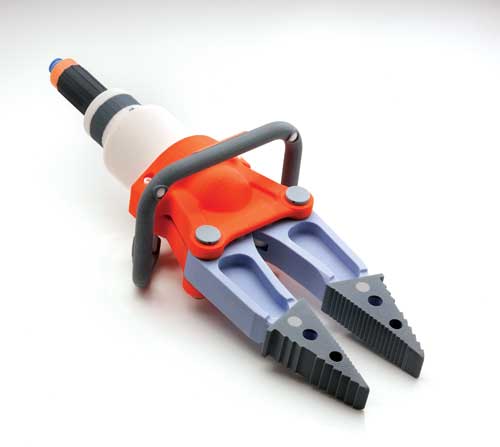
Parts made with ZCorp’s zp150 cost just $3 per cubic inch of material,
or about $20 for a typical handheld part. Photo courtesy of Z Corp.
Zp150 maintains ZCorp’s claim of being the most affordable 3D printing system by costing just $3 per cubic inch of material, or about $20 for a typical handheld part. Parts made with zp150 can be finished differently—and for strong functional performance, can be infiltrated with Z-Max resin.
This material works with the entire line of ZPrinters from ZCorp, from the $14,900 ZPrinter 150 to the top-of-the-line ZPrinter 650.
Blood Vessels of the Future
“The individual techniques are already functioning, and they are presently working in the test phase; the prototype for the combined system is being built,” says Dr. Gunter Tovar, who heads the BioRap project at the Fraunhofer Institute for Interfacial Engineering and Biotechnology IGB in Stuttgart. Tissue engineering is charged with printing a part of the vascular system, something as small and complex as a blood vessel that has tiny branches and spaces. The scientists at Fraunhofer Institute combine 3D printing technology with two-photon polymerization, which involves shining intense laser beams onto the material to stimulate the molecules. The material then becomes an elastic solid, which allows researchers to create highly precise and flexible structures that can interact with human body tissue. To keep the synthetic tubes from getting rejected by the living organism, researchers coat their walls with modified biomolecules. These biomolecules are part of the composition of the “inks” used in the blood vessel printer, combined with synthetic polymers. “We are establishing a basis for applying rapid prototyping to elastic and organic biomaterials,” Tovar says, noting that the 3D printer they use is a new prototype built by the Fraunhofer Gesellschaft. The same technology may one day make it possible to create artificial tissue and complex organs. |
MORE INFO
3D Systems
BioRap project
EnvisionTEC
Objet Geometries
Stratasys
Z Corp.
Susan Smith has been working as an editor and writer in the technology industry for more than 18 years. As an editor, she has been responsible for the launch of a number of technology trade publications, both in print and online. Currently, she is a contributing editor for Desktop Engineering. Contact her via [email protected].
Subscribe to our FREE magazine, FREE email newsletters or both!
Latest News
About the Author
DE’s editors contribute news and new product announcements to Digital Engineering.
Press releases may be sent to them via [email protected].







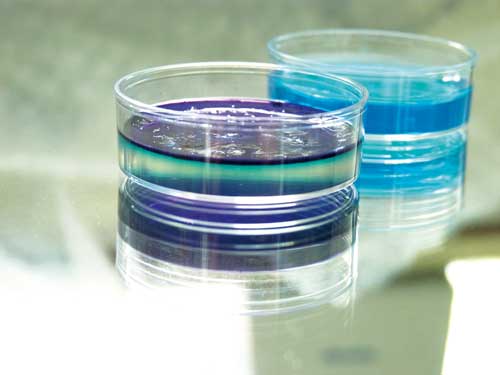 Tissue engineering researchers worldwide have been working on creating artificial tissue, and even entire organs, in the lab. Along those lines, a team at the Fraunhofer Gesellschaft in Germany has been experimenting with making artificial blood vessels on a 3D printer for use with transplants of lab-created organs. The challenge for tissue engineers has always been supplying artificial tissue with nutrients that must get to and from the organ via capillary vessels. The team believes they have solved that problem using 3D printing and a technique called multiphoton polymerization, developed in polymer science.
Tissue engineering researchers worldwide have been working on creating artificial tissue, and even entire organs, in the lab. Along those lines, a team at the Fraunhofer Gesellschaft in Germany has been experimenting with making artificial blood vessels on a 3D printer for use with transplants of lab-created organs. The challenge for tissue engineers has always been supplying artificial tissue with nutrients that must get to and from the organ via capillary vessels. The team believes they have solved that problem using 3D printing and a technique called multiphoton polymerization, developed in polymer science.